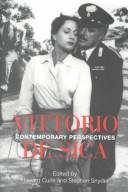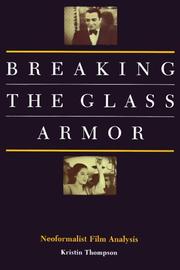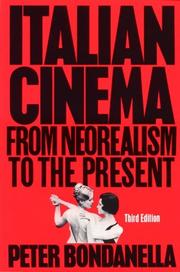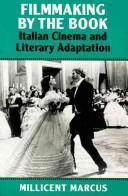| Listing 1 - 10 of 10 |
Sort by
|
Book
ISBN: 9780802095206 0802095208 9780802097613 0802097618 1442685670 144269243X 9781442685673 9781442692435 Year: 2007 Publisher: Toronto Buffalo, N.Y. University of Toronto Press
Abstract | Keywords | Export | Availability | Bookmark
 Loading...
Loading...Choose an application
- Reference Manager
- EndNote
- RefWorks (Direct export to RefWorks)
The end of the Second World War saw the emergence of neorealist film in Italy. In Italian Neorealist Cinema, Christopher Wagstaff analyses three neorealist films that have had significant influence on filmmakers around the world. Wagstaff treats these films as assemblies of sounds and images rather than as representations of historical reality. If Roberto Rossellini's Roma città aperta and Paisà, and Vittorio De Sica's Ladri di biciclette are still, half a century after they were made, among the most highly valued artefacts in the history of cinema, Wagstaff suggests that this could be due to the aesthetic and rhetorical qualities of their assembled narratives, performances, locations, lighting, sound, mise en scene, and montage. This volume begins by situating neorealist cinema in its historical, industrial, commercial and cultural context, and makes available for the first time a large amount of data on post-war Italian cinema. Wagstaff offers a theoretical discussion of what it means to treat realist films as aesthetic artefacts before moving on to the core of the book, which consists of three studies of the films under discussion. Italian Neorealist Cinema not only offers readers in Film Studies and Italian Studies a radically new perspective on neorealist cinema and the Italian art cinema that followed it, but theorises and applies a method of close analysis of film texts for those interested in aesthetics and rhetoric, as well as cinema in general.
Motion pictures --- Realism in motion pictures. --- Cinéma --- Réalisme dans le cinéma --- Aesthetics. --- History. --- Esthétique --- Histoire --- Rossellini, Roberto, --- De Sica, Vittorio --- Criticism and interpretation. --- Criticism and interpretation --- De Sica, Vittorio, --- Cinéma --- Réalisme dans le cinéma --- Esthétique
Book
ISBN: 9781844572380 Year: 2008 Publisher: London BFI
Abstract | Keywords | Export | Availability | Bookmark
 Loading...
Loading...Choose an application
- Reference Manager
- EndNote
- RefWorks (Direct export to RefWorks)
791.471 DE SICA --- De Sica Vittorio --- film --- filmgeschiedenis --- filmtheorie --- Italië --- neorealisme --- twintigste eeuw --- Ladri di biciclette (Motion picture) --- Voleur de bicyclette (Motion picture) --- Bicycle thief (Motion picture) --- Bicycle thieves (Motion picture) --- Sica, de, Vittorio

ISBN: 1281995975 9786611995973 1442683139 9781442683136 9781281995971 080200654X 0802083811 9780802083814 9780802006547 6611995978 Year: 2000 Publisher: Toronto, Ont. University of Toronto Press
Abstract | Keywords | Export | Availability | Bookmark
 Loading...
Loading...Choose an application
- Reference Manager
- EndNote
- RefWorks (Direct export to RefWorks)
Recognized as a master of Italian cinema, Vittorio De Sica is perhaps best known and most respected for his critically acclaimed neorealist films of the period 1946-55. As this anthology reveals, however, his production was remarkably multifaceted. The essays included here - some newly commissioned, some reprinted, and others in translation - look at De Sica's varied career from many perspecives. Structured chronologically, the volume begins by introducing readers to De Sica's early popularity as an actor and singer during the years of Italian Fascism, and to his initial directorial efforts before the end of World War II. It was not until the postwar era, however, that De Sica made his mark in film history. Special attention is given to this critical phase of his career, which encompasses the neorealist films that made him famous: "Shoeshine", "Bicycle Thieves", "Miracle in Milan", and "Umberto D."When the neorealist movement waned after 1955, De Sica returned to his roots in Neapolitan comedy for a series of commercially successful films starring Sophia Loren and Marcello Mastroianni. Memorable works from this period include "Two Women" and "Marriage Italian Style" as well as "Yesterday, Today, and Tomorrow", which won De Sica an Academy Award in 1965. In one of his final films, "The Garden of the Finzi Continis", he returned to the subject of World War II and to the human tragedy characteristic of his best neorealist productions. This fine anthology offers a comprehensive critical survey that covers the entire scope of De Sica's career, and is an excellent resource for students, critics and film enthusiasts.
De Sica, Vittorio, --- De Sika, Vittorio, --- Sica, Vittorio de, --- Ṭi. Cikā, Vikṭōriyā, --- De Sica, V. --- Sica, V. de --- Criticism and interpretation. --- De Sika, Vittorio --- Film --- Films. --- PERFORMING ARTS --- Electronic books. --- De Sica, Vittorio, -- 1901-1974 -- Criticism and interpretation. --- Neorealismus. --- Film & Video --- History & Criticism. --- Direction & Production.
Book
ISBN: 9780826417855 9781441160690 1441160698 082641785X Year: 2009 Publisher: New York: Bloomsbury,
Abstract | Keywords | Export | Availability | Bookmark
 Loading...
Loading...Choose an application
- Reference Manager
- EndNote
- RefWorks (Direct export to RefWorks)
Motion pictures --- History --- 798.43 --- Bertolucci, Bernardo --- De Sica --- Fellini, Federico --- Pasolini, Pier Paolo --- Rosselini --- Visconti, Luchino --- neorealisme --- spaghetti western --- film, geschiedenis der filmkunst, overige landen --- Film --- Italy --- Italië --- Motion pictures - Italy - History

ISBN: 0691014531 0691067244 0691213151 Year: 1988 Publisher: Princeton, N.J.
Abstract | Keywords | Export | Availability | Bookmark
 Loading...
Loading...Choose an application
- Reference Manager
- EndNote
- RefWorks (Direct export to RefWorks)
Film --- #SBIB:309H523 --- #SBIB:309H524 --- film --- filmtheorie --- neoformalisme --- Neil Roy WIlliam --- Tati Jacques --- Godard Jean-Luc --- Hitchcock Alfred --- Preminger Otto --- De Sica Vittorio --- Renoir Jean --- Bresson Robert --- Ozu Yasujiro --- 791.41 --- 791.43.01 --- Audiovisuele communicatie: verhaalanalyse --- Audiovisuele communicatie: semiotiek --- Filmologie. Filmtheorie. Esthetica van de film --- 791.43.01 Filmologie. Filmtheorie. Esthetica van de film --- Motion pictures

ISBN: 0826412475 Year: 2001 Publisher: New York (N.Y.) : Continuum,
Abstract | Keywords | Export | Availability | Bookmark
 Loading...
Loading...Choose an application
- Reference Manager
- EndNote
- RefWorks (Direct export to RefWorks)
film --- filmgeschiedenis --- twintigste eeuw --- Italië --- neorealisme --- Rosselini Roberto --- De Sica Vittorio --- Visconti Luchino --- Antonioni Michelangelo --- Fellini Federico --- spaghettiwesterns --- westerns --- Leone Sergio --- Pasolini Pier Paolo --- Bertolucci Bernardo --- Moretti Nanni --- Avati Pupi --- Scola Ettore --- Taviani Paolo --- Taviani Vittorio --- Wertmüller Lina --- Cavani Liliana --- Bellocchio Marco --- Petri Elio --- 791.43 --- Motion pictures --- History --- History.
Book
ISBN: 1442685670 9781442685673 9781442692435 144269243X 9780802097613 0802097618 9780802095206 0802095208 Year: 2008 Publisher: Toronto
Abstract | Keywords | Export | Availability | Bookmark
 Loading...
Loading...Choose an application
- Reference Manager
- EndNote
- RefWorks (Direct export to RefWorks)
The end of the Second World War saw the emergence of neorealist film in Italy. In Italian Neorealist Cinema, Christopher Wagstaff analyses three neorealist films that have had significant influence on filmmakers around the world. Wagstaff treats these films as assemblies of sounds and images rather than as representations of historical reality. If Roberto Rossellini's Roma città aperta and Paisà, and Vittorio De Sica's Ladri di biciclette are still, half a century after they were made, among the most highly valued artefacts in the history of cinema, Wagstaff suggests that this could be due to the aesthetic and rhetorical qualities of their assembled narratives, performances, locations, lighting, sound, mise en scene, and montage. This volume begins by situating neorealist cinema in its historical, industrial, commercial and cultural context, and makes available for the first time a large amount of data on post-war Italian cinema. Wagstaff offers a theoretical discussion of what it means to treat realist films as aesthetic artefacts before moving on to the core of the book, which consists of three studies of the films under discussion. Italian Neorealist Cinema not only offers readers in Film Studies and Italian Studies a radically new perspective on neorealist cinema and the Italian art cinema that followed it, but theorises and applies a method of close analysis of film texts for those interested in aesthetics and rhetoric, as well as cinema in general.
Realism in motion pictures. --- Motion pictures --- History. --- Aesthetics. --- De Sica, Vittorio, --- Rossellini, Roberto, --- Criticism and interpretation. --- Cinema --- Feature films --- Films --- Movies --- Moving-pictures --- Realism in moving-pictures --- History and criticism --- De Sika, Vittorio, --- Sica, Vittorio de, --- Ṭi. Cikā, Vikṭōriyā, --- De Sica, V. --- Sica, V. de --- Audio-visual materials --- Mass media --- Performing arts --- De Sika, Vittorio --- Rossellini, Roberto --- Italien. --- Italien --- Italy. --- Italia --- Italian Republic --- Italianska republika --- Italʹi͡anskai͡a Rėspublika --- Italie --- Italii͡ --- Italii͡a Respublikasi --- Italiĭsʹka Respublika --- Itālija --- Itālijas Republika --- Italijos Respublika --- Italikē Dēmokratia --- Īṭāliy --- Italiya Respublikasi --- It'allia --- It'allia Konghwaguk --- İtalya --- İtalya Cumhuriyeti --- Iṭalyah --- Iṭalye --- Itaria --- Itaria Kyōwakoku --- Jumhūrīyah al-Īṭālīyah --- Kgl. Italienische Regierung --- Königliche Italienische Regierung --- Laško --- Lýðveldið Ítalía --- Olasz Köztársaság --- Olaszország --- Regno d'Italia --- Repubblica italiana --- Republiḳah ha-Iṭalḳit --- Włochy --- Yidali --- Yidali Gongheguo --- Italy --- Königreich Italien --- Repubblica Italiana --- Olaszorszaǵ --- Olasz Koz̈taŕsasaǵ --- Italienische Republik --- République Italienne --- Yidali-gongheguo --- Italiener --- Königreich Sardinien --- Republik von Salò --- 17.03.1861 --- -Motion pictures

ISBN: 080184455X Year: 1993 Publisher: Baltimore, Md Johns Hopkins University Press
Abstract | Keywords | Export | Availability | Bookmark
 Loading...
Loading...Choose an application
- Reference Manager
- EndNote
- RefWorks (Direct export to RefWorks)
Literary semiotics --- Film --- Italy --- 791.43:82 --- 791.44 --- #SBIB:309H1324 --- film --- 791.43 --- 791.41 --- gender studies --- feminisme --- psychoanalyse --- semiologie --- semiotiek --- Taviani Paolo --- Taviani Vittorio --- Fellini Federico --- Pasolini Pier Paolo --- De Sica Vittorio --- Visconti Luchino --- filmtheorie --- film en literatuur --- twintigste eeuw --- Italië --- literatuur --- Film en literatuur --- Filmproductie. Filmindustrie --- Films met een amusementsfunctie en/of esthetische functie: film en literatuur --- Film adaptations. --- Italian literature --- Motion pictures and literature --- Motion pictures --- Film and video adaptations. --- 791.43:82 Film en literatuur --- 791.44 Filmproductie. Filmindustrie --- Film adaptations --- Literature and motion pictures --- Moving-pictures and literature --- Literature --- Ottovolante (Group of writers) --- Adaptations, Film --- Books, Filmed --- Filmed books --- Films from books --- Motion picture adaptations --- Film and video adaptations --- Adaptations
Book
ISBN: 9781487507107 1487507100 1487535570 1487535589 Year: 2020 Publisher: Toronto ; Buffalo ; London : University of Toronto Press,
Abstract | Keywords | Export | Availability | Bookmark
 Loading...
Loading...Choose an application
- Reference Manager
- EndNote
- RefWorks (Direct export to RefWorks)
"Neorealism emerged as a cultural exchange and a field of discourse that served to shift the confines of creativity and revise the terms of artistic expression not only in Italy but worldwide. If neorealism was thus a global phenomenon, it is because of its revolutionary portrayal of a transformative moment in the local, regional, and national histories of Italy. At once guiding and guided by that transformative moment, neorealist texts took up, reflected, and performed the contentious conditions of their creation, not just at the level of narrative content but also in their form, language, and structure. Italian Neorealism: A Cultural History demonstrates how they did so through a series of representative case studies. Recounting the history of a generation of artists, this study offers fundamental insights into one of the most innovative and influential cultural moments of the twentieth century."--
Motion pictures --- Realism in motion pictures. --- Motion pictures. --- History. --- Italy. --- Elio Vittorini. --- Fascism. --- Italian Film. --- Italian Literature. --- Italo Calvino. --- Luchino Visconti. --- Neorealism. --- Roberto Rossellini. --- Vittorio De Sica. --- artistic movements. --- cultural history. --- modern art. --- realism. --- Italia --- Italian Republic --- Italianska republika --- Italʹi͡anskai͡a Rėspublika --- Italie --- Italien --- Italii͡ --- Italii͡a Respublikasi --- Italiĭsʹka Respublika --- Itālija --- Itālijas Republika --- Italijos Respublika --- Italikē Dēmokratia --- Īṭāliy --- Italiya Respublikasi --- It'allia --- It'allia Konghwaguk --- İtalya --- İtalya Cumhuriyeti --- Iṭalyah --- Iṭalye --- Itaria --- Itaria Kyōwakoku --- Jumhūrīyah al-Īṭālīyah --- Kgl. Italienische Regierung --- Königliche Italienische Regierung --- Laško --- Lýðveldið Ítalía --- Olasz Köztársaság --- Olaszország --- Regno d'Italia --- Repubblica italiana --- Republiḳah ha-Iṭalḳit --- Włochy --- Yidali --- Yidali Gongheguo --- Italy

ISBN: 0393979830 9780393979831 Year: 2005 Publisher: New York Norton
Abstract | Keywords | Export | Availability | Bookmark
 Loading...
Loading...Choose an application
- Reference Manager
- EndNote
- RefWorks (Direct export to RefWorks)
Motion pictures --- 791.41 --- Almodovar Pedro --- Bergman Ingmar --- Buñuel Luis --- Burnett Charles --- Capra Frank --- Chaplin Charlie --- Cissé Souleymane --- Coppola Francis Ford --- Curtiz Michael --- Dali Salvador --- Dash Julie --- De Sica Vittorio --- Donen Stanley --- Eisenstein Sergei --- Fassbinder Rainer Werner --- Fellini Federico --- film --- filmanalyse --- filmtheorie --- Flaherty Robert J --- Ford John --- Godard Jean-Luc --- Griffith D.W --- Gutiérrez Alea Tomas --- Hark Tsui --- Hawks Howard --- Hitchcock Alfred --- Keaton Buster --- Kelly Gene --- Kiarostami Abbas --- Kubrick Stanley --- Kurosawa Akira --- Lang Fritz --- Lee Spike --- Lumière Auguste --- Lumière Louis --- Méliès Georges --- Mizoguchi Kenji --- Ozu Yasujiro --- Polanski Roman --- Ray Satyajit --- Renoir Jean --- Rossellini Roberto --- Scorsese Martin --- Sembene Ousmane --- Truffaut François --- twintigste eeuw --- Welles Orson --- Wiene Robert --- Wilder Billy --- Zhang Yimou --- Cinema --- Feature films --- Films --- Movies --- Moving-pictures --- Audio-visual materials --- Mass media --- Performing arts --- History and criticism --- Motion pictures. --- Film
| Listing 1 - 10 of 10 |
Sort by
|

 Search
Search Feedback
Feedback About UniCat
About UniCat  Help
Help News
News